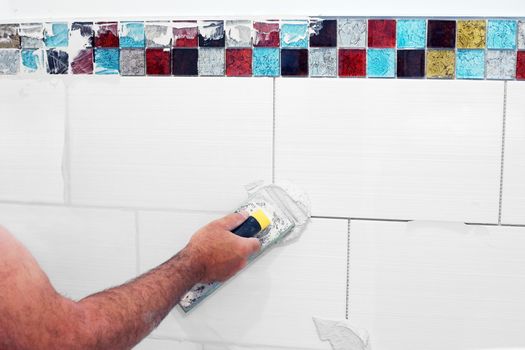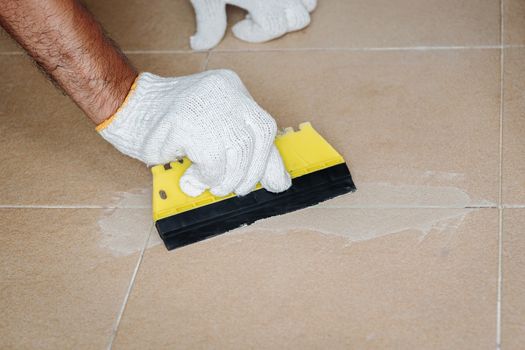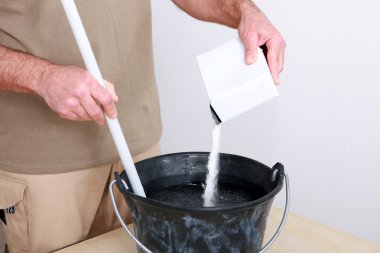- Home
- How to Dispose of Household Hazardous Waste
- How to Dispose of Grout Water
how to dispose of grout water-Can You Dump in the Drain?
The process of replacing or repairing tile grouting can be a time-intensive task, yet it is essential for maintaining the integrity of your space. While the job may seem straightforward, there are certain precautions you must take to ensure the job is done correctly.
Knowing how to properly dispose of grout water is one of them. Grout water consists of a mixture of dirt and other particles, and if not disposed of correctly, it can have potentially harmful effects on the environment. Here, we will provide a comprehensive guide on how to safely and effectively dispose of grout water.
From the type of receptacle to use, to the disposal methods that should be employed, we will cover everything you need to know about safely disposing of grout water in a responsible manner.
recommended methods for disposing of grout water safely
Settling and Skimming Method
- Let the grout water settle in a bucket for a few days.
- Pour off the clear water on top, leaving the grout residue at the bottom.
- Dispose of the remaining solids in the trash
Evaporation Method:
- Use two buckets alternately to allow water to evaporate.
- Once the water has evaporated, collect the remaining grout residue.
- Wrap the moist residue in paper and dispose of it in the trash to avoid silica dust
Solidification Method:
- Pour the grout water onto a piece of plywood or landscape mesh.
- Allow it to dry, then scrape off the dried grout and dispose of it in the trash
Containment Method:
- Pour the grout water into a lined trash can or a disposable plastic container.
- Let it harden overnight, then discard the solidified grout as solid waste
what is grout water?
Grout water is a type of wastewater produced during the tile grouting process. This wastewater contains a mixture of cement, sand and other particulate material that has the potential to adversely affect water treatment systems.
Proper management of this wastewater can help prevent water contamination and the spread of diseases such as cholera and dysentery. To reduce the amount of grout water released into the environment, proper handling and disposal methods must be put in place.
This includes using grout water containment systems, as well as treating it before release into surface water or municipal sewage systems.

the importance of safely disposing of grout water
Improper disposal of grout water can have serious environmental and health risks. When grout water is poured down drains or into the soil, it can carry high levels of salts, metals, and other contaminants that can harm aquatic life, threaten groundwater quality, and cause corrosion to plumbing systems.
Additionally, when grout water is not properly disposed of, it provides the perfect breeding environment for bacteria and fungal growth such as mold and mildew which can contaminate indoor air quality, leading to potential respiratory health effects.
Improper disposal of grout water can also cause damage to septic tanks and sewage treatment plants due to its impact on microbial activity in the tanks. Furthermore, improper disposal of grout water may lead to fines from local authorities as discharging hazardous substances without a permit is illegal in many jurisdictions.
1. Prepare a bucket with a tight-fitting lid
Before beginning any grouting project, it is essential to prepare a bucket with a tight-fitting lid for collecting and containing the grout water. This bucket should be placed on a flat surface before use, to ensure that excess water does not spill out during transportation.
After use, the grout water must be disposed of with care, and in accordance with local regulations. Following this safety precaution ensures that the environment remains free from contaminants and keeps your project up to standard.
2. Use a ladle to transfer the grout water into the container
When disposing of grout water, it is essential to do so with safety and efficiency in mind. Step two of the process involves transferring the grout water in its container into a designated receptacle with a ladle.
It is important that the ladle is of sufficient size to accommodate all of the contents from the source container. Furthermore, to reduce the risk of spills, the ladle should be held at a low angle while being filled. Once the transfer is complete, the containing vessel should be sealed and disposed of in accordance with local regulations.
3. Place the lid securely over the bucket
It is important to ensure a secure lid is placed on the bucket once the grout water has been disposed of. This serves as an effective method to contain any remaining moisture and stop the spread of contaminants due to accidental spills or splashing.
Additionally, attaching a secure lid serves as a warning for others when the bucket is transported to its final destination. It helps to protect workers, bystanders, and anyone in contact with the bucket by indicating potential hazardous contents within.
4. Take the container to a local hazardous waste facility
It is essential to dispose of grout water in a safe and responsible manner. To do so, one should take the container holding the grout water to their local hazardous waste facility. This type of facility will be able to safely and responsibly handle the hazardous materials contained within.
It is best to contact your local government for more information about where to find a nearby hazardous waste facility, as well as any instructions that may be necessary for proper disposal. Following these steps ensures that the grout water is disposed of in an appropriate and environmentally conscious fashion.
5. Contact local authorities for collection dates and times
It is essential to contact local authorities concerning the collection dates and times for grout water and other construction waste. Depending on specific guidelines, collection times can vary significantly by locality.
Planning ahead is important to ensure that correct disposal is conducted in a timely manner; scheduling a pickup date with the relevant local authority ensures that this is achieved. It is crucial to abide by regulations when disposing of grout water and other construction waste, so contacting local authorities for collection dates and times is paramount.
6. Ensure the container is appropriately labeled with the hazardous warning
It is of utmost importance to ensure that any container used for collecting and disposing of grout water is labeled with a hazardous warning. This warning should include the potential hazards associated with the grout water, such as skin and eye irritation, in order to avoid any accidental contact or ingestion.
To ensure proper disposal and record-keeping, the container should also be labeled with the date, time, and purpose of the grout water collection. If this protocol is strictly followed all necessary precautions can be taken to protect individuals from potential harm due to the handling of hazardous materials.
7. Transport the container in accordance with local regulations
Once grout water has been collected and filtered, it must be safely transported in accordance with the rules of local municipalities. Depending on the amount and type of grout water being transported, necessary precautions such as labeling the containers for hazardous material handling and providing a sealed container may need to be taken.
In order to follow the regulations associated with the transportation of grout water, anyone who needs to transport the substance should check their local municipality's rules regarding vehicle suitability for carrying hazardous materials, as well as any special permits or other requirements that may be necessary. By taking these precautions, you can ensure that all safety requirements are met when transporting grout water.
8. Wear protective gloves and clothing when disposing of the waste
When disposing of grout water, it is essential to take safety precautions to protect yourself and the environment. Before handling the water, always put on protective gloves and clothing to avoid potential irritants or chemical reactions coming into contact with your skin.
Additionally, ensure a safe working environment by wearing a respirator or face mask when dealing with any grouting mist or fumes that may be present. By following these measures, you will not only protect yourself from harm but also guarantee a healthy environment for future generations.
9. Follow all instructions provided by the hazardous waste facility
All individuals disposing of grout water at hazardous waste facilities are required to adhere to specific protocols. It is essential to read any instructions provided and comply with them fully, including requirements for acceptable containers and labeling.
Furthermore, it is advisable to be aware of any associated fees and have the necessary paperwork when applicable. Non-compliance with the facility's procedures can lead to delays or rejection of your waste material. It is therefore essential to take all necessary precautions to ensure successful disposal.
10. Clean the work area thoroughly after disposing of the grout water
It is important to thoroughly clean the area after disposing of grout water. All surfaces that may have come into contact with the grout water or its residue must be wiped down, paying extra attention to areas around the sink.
Additionally, used items such as sponges, rags, mop heads, etc. should be replaced, as they can become a breeding ground for mold and bacteria if not thrown away. Thoroughly cleaning the work environment is critical for maintaining a safe and healthy atmosphere.
Other useful tips to properly dispose of grout water

Disposing of grout water is an important part of tiling work. Properly disposing of grout water helps prevent damage to your plumbing and the environment. Here are a few steps you can take to make sure your grout water disposal is done properly:
1. Never pour grout water directly down a drain or into a toilet. The mixture of grit, chemicals, and water can damage pipes and cause fewer water pressure.
2. If possible, direct the grout water outside away from plants or greenery to avoid exposing any fragile or delicate plants to the harsh chemicals involved in tile grouting.
3. Never pour grout water into a stormwater drain as this could potentially pollute nearby streams and rivers.
4. If you need to dispose of grout water indoors, use a funnel and a bucket, and follow local regulations to determine what to do with it.
5. Make sure to always read and follow the manufacturer’s instructions for disposing of grout waste in order to safeguard yourself and your environment.
6.For small amounts of grout water, put it in a sealed container and dispose of it in a dedicated container specifically marked for hazardous waste.
7. For larger amounts, use a sump pump to collect and transport the grout water away from the building and dispose of it in a special collection container or designated hazardous waste facility.
8. If this is not possible in your area, then use an absorbent material such as kitty litter to soak up some of the moisture before you dispose of it.
You may also like how to dispose of hazardous household waste
Can grout be washed down the drain?
Grout is a cement- or epoxy-based material used to fill gaps between tiles. When it comes to washing grout down the drain, the answer is a bit more complicated than it seems. If grout is made of non-water-soluble, cement-based materials, there may be a risk of clogging the drain due to its relatively low solubility.
However, if it is composed of a water-soluble epoxy compound, then it should wash away with nothing more than some warm running water. In either case, though, it is best to take extra precautions when disposing of any kind of grout, as small particles could get lodged in the pipes and lead to slow drainage or possible clogs.
Professionals typically recommend that grout be disposed of in lined receptacles or bags to ensure that none of it escapes into the sewage system.
How to dispose of unused grout powder?
Disposing of grout powder correctly is vital to protecting the environment. Unused grout powder should be placed in a plastic bag, sealed shut, and taken to your local hazardous waste disposal center.
The facility will then identify the proper procedure for disposing of the powder, whether it be secure storage, incineration, or recycling.
Before taking unused grout powder to a hazardous waste facility, be sure to contact your local government or a hazardous waste disposal expert to ensure you adhere to all regulations and safety protocols. By properly disposing of grout powder, you can help protect our planet's precious resources.
More on how to properly dispose of unused grout powder
How to get dried grout out of a bucket?
The removal of dried grout from a bucket is a delicate process requiring a few steps to ensure that the grout is carefully removed and does not damage the bucket. First, empty the remaining wet grout from the bucket into a container that can safely contain it.
Next, fill the bucket with warm water, enough to submerge the dried grout, and let it soak for at least an hour. After this initial soaking period, use a stiff brush to scrape away any remaining pieces of grout from the sides and bottom of the bucket. Then dump out the water and refill the bucket with more warm water and mild detergent.
Allow the solution to sit for another hour before gently scrubbing the surface with a soft cloth. Finally, rinse the bucket with clean water and allow it to air dry. Following these steps will get your bucket completely free of any dried grout.
How to get dried grout off ceramic tile?
To effectively remove dried grout from ceramic tile, you will need to prepare a solution of warm water and mild detergent. Gently scrub the affected area with a stiff brush, paying special attention to any tough stains. Once finished, be sure to completely rinse away all soapy residue with clean, cold water.
For even more intensive cleaning, an abrasive cleaner or steel wool can be used. Care should always be taken to avoid scratching or damaging the ceramic tile, however; if necessary, use a soft cloth such as microfiber or flannel to help protect the surface from scratches. Lastly, use a dry towel to thoroughly dry the area and restore its original luster and shine.
How to get dried grout off porcelain tile?
Removing dried grout from porcelain tiles can be a challenging task. Fortunately, there are several methods you can use to achieve this goal. One method is to create a paste from baking soda and water and apply it to the tile. Use an old toothbrush to work the paste into the grout lines, then rinse off with warm water.
For stubborn areas of grout, use a combination of vinegar and hydrogen peroxide blended with a scrubbing pad and lightly scrub until the grout comes free. As an alternative, use a commercial grout removal product available at most hardware stores.
Before using any chemical product, always take time to read the label instructions carefully and test it in a small area first. With the right approach and cleaning products, you can get dried grout off of your porcelain tile quickly and efficiently.
How to soften grout for removal?
Softening grout for removal is an important step before attempting to replace or remove old grout. Grout is a cement-based adhesive that dries quickly and can bind strongly to tiles or other surfaces, making it difficult to remove. To soften the grout, it is necessary to apply heat and moisture to the grout in order to make it easier to remove.
This can be done by heating up a metal tool such as an iron or steamer, then applying it over the grout for several minutes until the grout softens. It may also be beneficial to add moisture directly to the grout with a spray bottle or damp rag. When the grout is sufficiently softened, it may be scraped away with a grout removal tool or chisel.
Is there a product that dissolves grout?
GROUT AWAY – Tilers Grout Dissolver is a revolutionary product that helps to tackle the complex problem of hard-to-remove grout. This professional-grade product has been developed for tile contractors and DIY enthusiasts alike, providing an easy and efficient solution to stubborn grout issues.
It is inexpensive, long-lasting, and easy to use – simply spray onto the affected grout areas and leave for 5-10 minutes before rinsing with water or a damp cloth. GROUT AWAY – Tilers Grout Dissolver is guaranteed to help save time and money when it comes to removing old and discolored grout and restoring your tiled surfaces to their original glory.
how to dispose of grout water? conclusion
Properly disposing of grout water is an essential step in maintaining a healthy environment. Containment of grout water can be accomplished by utilizing proper containers and taking the necessary steps to ensure that runoff is not released into waterways or other regions.
Additionally, diluting the grout water with clean water prior to disposal may reduce its impact on the environment. If dilution is not possible, then hazardous waste facilities should be utilized for proper disposal. By taking the time to safely dispose of grout water, individuals can minimize the risk of environmental contamination or plumbing system damage.
It is important to understand that failure to properly manage grout water can lead to severe consequences for both people and the environment as a whole.
